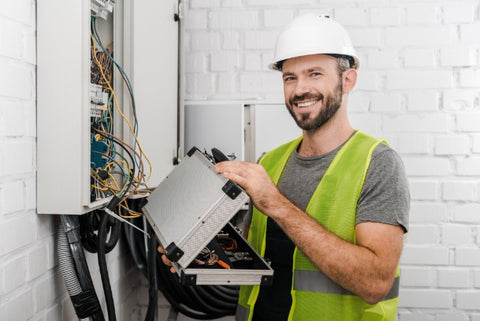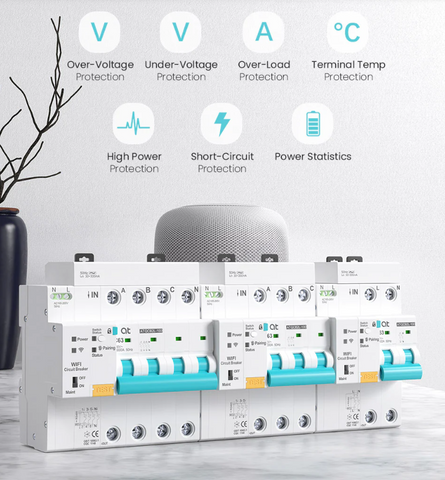Troubleshooting Made Easy: How Smart Breakers Simplify Electrical Repairs
Inside this Article:
- I. Understanding Traditional Electrical Troubleshooting
- A. Common Electrical Problems Homeowners Face
- B. Traditional Methods of Identifying and Resolving Electrical Issues
- C. Limitations and Challenges of Traditional Troubleshooting Approaches
- II. Introducing Smart Breakers
- A. Definition and Basic Functionality of Smart Breakers
- B. How Smart Breakers Differ from Traditional Circuit Breakers
- C. Overview of the Technology Behind Smart Breakers
- III. Advantages of Smart Breakers in Troubleshooting
- A. Real-time Monitoring Capabilities
- B. Remote Access and Control Features
- C. Automatic Fault Detection and Notification
- D. Enhanced Safety Features
- IV. Step-by-Step Guide to Troubleshooting with Smart Breakers
- A. Installation and Setup Process
- B. Using Mobile Apps or Smart Home Platforms for Monitoring
- C. Interpreting Alerts and Notifications
- D. Remote Troubleshooting and Control
- V. Case Studies
- A. Real-World Examples of Homeowners Benefiting from Smart Breakers
- B. Success Stories of Simplified Electrical Repairs
- C. Comparisons Between Traditional and Smart Breaker Experiences
- VI. Potential Challenges and Solutions
- A. Common Issues Users Might Face with Smart Breakers
- B. Troubleshooting Tips for Resolving Problems with Smart Breaker Systems
- VII. Conclusion

With the convenience of electricity comes the inevitable challenge of troubleshooting electrical issues. Homeowners often find themselves grappling with various problems, from tripped circuits to mysterious power outages. Traditional methods of identifying and resolving these issues can be time-consuming, frustrating, and sometimes even hazardous.
Enter the game-changer—smart circuit breakers. These innovative devices are revolutionizing the way we approach electrical repairs. Smart breakers are becoming popular for homeowners who want a safer, more efficient, and easier way to fix electrical issues.
I. Understanding Traditional Electrical Troubleshooting
A. Common Electrical Problems Homeowners Face
To understand smart breakers, it's important to know the common electrical issues homeowners often face. These can range from overloaded circuits and short circuits to faulty wiring and power surges.
B. Traditional Methods of Identifying and Resolving Electrical Issues
Traditional troubleshooting methods involve a step-by-step process of manually inspecting and testing circuits, outlets, and appliances. While effective, these methods often require technical expertise and can be time-intensive.
C. Limitations and Challenges of Traditional Troubleshooting Approaches
The traditional approach has its limitations. Identifying hidden faults or understanding real-time electrical consumption isn't always straightforward. Also, without remote monitoring, homeowners struggle to quickly deal with problems, especially when they are not at home.
II. Introducing Smart Breakers
A. Definition and Basic Functionality of Smart Breakers
Smart circuit breakers, at their core, are advanced versions of traditional circuit breakers equipped with intelligent features. They combine electrical protection with cutting-edge technology to offer a comprehensive solution for monitoring and managing electrical systems.
B. How Smart Breakers Differ from Traditional Circuit Breakers
Smart breakers are different because they can give data instantly, control circuits from a distance, and find and fix problems automatically. This transformative shift from passive to proactive electrical management empowers homeowners with a new level of control and awareness.
C. Overview of the Technology Behind Smart Breakers
The technology behind smart circuit breakers involves sensors, communication modules, and advanced algorithms. These parts work together to check electrical measurements, connect with smart home systems, and send immediate notifications if something is wrong. Understanding this technology is key to unlocking the full potential of smart breakers in simplifying electrical repairs.
III. Advantages of Smart Breakers in Troubleshooting
A. Real-time Monitoring Capabilities
One of the standout features of smart breakers is their ability to provide real-time monitoring of electrical systems. Homeowners can gain instant insights into their power consumption, voltage fluctuations, and individual circuit performance. This real-time data empowers users to identify issues proactively before they escalate, ultimately preventing potential electrical failures.
B. Remote Access and Control Features
Smart breakers take electrical management to the next level with remote access and control capabilities. You can control and monitor your electrical circuits using mobile apps or smart home platforms, no matter where you are. This not only adds convenience but also enables users to respond promptly to unexpected events without being physically present.
C. Automatic Fault Detection and Notification
Gone are the days of manual circuit checks. Smart breakers leverage advanced algorithms to automatically detect faults within the electrical system. The smart breaker detects problems like short circuits, overloads, or abnormal voltage and alerts the homeowner immediately. This proactive approach to fault detection minimizes downtime and ensures a swift response to potential hazards.
D. Enhanced Safety Features
Safety is paramount when dealing with electricity, and smart breakers prioritize this aspect. They come equipped with enhanced safety features, such as the ability to remotely disconnect power in emergency situations. This feature not only protects the home and its occupants but also prevents further damage to appliances and electronics.
IV. Step-by-Step Guide to Troubleshooting with Smart Breakers
A. Installation and Setup Process

1. Gather Necessary Tools
Before starting the installation process, ensure that you have the necessary tools such as a screwdriver and wire stripper. Additionally, gather any additional parts that are included with the smart breaker.
2. Turn Off Power
Safety first! Turn off the main power supply to your electrical panel before attempting to install the smart breaker. This step is crucial to prevent any accidents during the installation process.
3. Replace the Existing Breaker
Carefully remove the existing circuit breaker and replace it with the smart breaker. Follow the manufacturer's instructions for a secure installation. Make sure the breaker is firmly seated and connected to the appropriate wires.
4. Power On and Connect
Once the installation is complete, restore power to the electrical panel. Ensure that the smart breaker is receiving power and connecting to the electrical system properly.
B. Using Mobile Apps or Smart Home Platforms for Monitoring
1. Download the App
Go to your phone or tablet's app store and get the app made by the smart breaker company.
2. Create an Account
Open the app and create an account if required. This account will serve as your gateway to remotely monitor and control your electrical system.
3. Connect to the Smart Breaker
Follow the app's instructions to connect it to your smart breaker.
4. Explore Monitoring Features
Once connected, explore the monitoring features offered by the app. See live data, check circuit status, and learn about your electrical system layout.
C. Interpreting Alerts and Notifications
1. Enable Notifications
Ensure that notifications are enabled in the app settings. This will allow the smart breaker to send alerts to your device in case of any issues.
2. Understand Alert Types
Familiarize yourself with the different types of alerts the smart breaker can generate. These may include notifications for overloads, short circuits, or unusual power consumption. Understanding each alert type will help you take appropriate action.
3. Responding to Alerts
When an alert is received, open the app to view the details. The app will often provide guidance on how to address the issue. Whether it's turning off a specific circuit or seeking professional help, prompt action can prevent further problems.
D. Remote Troubleshooting and Control

1. Troubleshoot from Anywhere
In the event of an issue, use the app to troubleshoot remotely. This could mean turning off power to a certain circuit or doing a diagnostic check to find the problem.
2. Control Circuits Remotely
Take advantage of the remote control features to turn off or reset circuits from the app. This capability is especially useful when you're away from home and need to address electrical issues promptly.
3. Seek Professional Help if Needed
If the problem continues or needs professional help, use the app to collect information before calling an electrician. The data provided by the smart breaker can assist in a more targeted and efficient resolution.
With this guide, homeowners can fully utilize smart circuit breakers as powerful tools for monitoring, troubleshooting, and controlling their electrical systems. Next, we'll look at real-life cases where people have gained from using smart breakers in their houses.
V. Case Studies
These real-world case studies underscore the tangible benefits that homeowners can experience by embracing smart circuit breakers. Intelligent technology in homes brings safety, troubleshooting, time and cost savings, transforming our lives. As we study electrical systems, these examples show how smart breakers are becoming more important in making our lives easier.
A. Real-World Examples of Homeowners Benefiting from Smart Breakers
Case 1: Proactive Energy Management
Meet Sarah, a homeowner concerned about rising energy bills. By installing smart breakers, she gained real-time insights into her energy consumption. Identifying power-hungry appliances, Sarah adjusted her usage patterns, resulting in a significant reduction in her monthly bills. The ability to monitor and control energy consumption empowered Sarah to make informed decisions about her household's electricity usage.
Case 2: Timely Fault Detection
John experienced frequent tripped circuits in his home. With smart breakers, he received instant notifications about the specific circuits causing issues. This allowed him to address the problem promptly, preventing potential electrical hazards. The automatic fault detection feature proved invaluable in maintaining the safety of John's home and avoiding costly repairs.
B. Success Stories of Simplified Electrical Repairs
Case 3: Remote Troubleshooting Saves the Day
When Lisa's refrigerator suddenly stopped working while she was away on vacation, panic set in. Fortunately, smart breakers allowed her to troubleshoot the issue remotely. She found a problem with the circuit, fixed it with the app, and saved lots of money on spoiled food. The ability to address the problem without a service call showcased the convenience and cost-effectiveness of smart technology.
Case 4: Streamlined Renovation with Smart Breakers
Mark decided to renovate his home, including updating the electrical system. Smart breakers simplified the process by providing real-time data on power usage during construction. Mark could identify overloaded circuits, optimize power distribution, and ensure the safety of his contractors. The smart breaker experience transformed what could have been a complicated renovation into a streamlined and efficient project.
C. Comparisons Between Traditional and Smart Breaker Experiences
Case 5: From Reactive to Proactive Maintenance
Emily had experienced several power outages due to issues with her electrical panel. After upgrading to smart circuit breakers, she contrasted the experience with traditional troubleshooting.
In the past, she would wait for a complete failure before calling an electrician. With smart breakers, she received alerts about potential issues, allowing for proactive maintenance. The comparison highlighted the shift from reactive to proactive electrical management.
Case 6: Time and Cost Savings
David, a busy homeowner, used to dislike the time-consuming task of finding and repairing electrical problems. With smart breakers, he saved both time and money. The ability to remotely troubleshoot and control circuits meant fewer service calls and quicker resolution of problems. The comparison emphasized the efficiency gains and cost savings associated with smart breaker technology.
VI. Potential Challenges and Solutions

A. Common Issues Users Might Face with Smart Breakers
1. Connectivity Issues
Users may encounter challenges with smart breaker connectivity, leading to intermittent monitoring or control problems.
2. False Alarms
Erroneous alerts may cause unnecessary concern. Understanding the reasons behind false alarms can help users differentiate between genuine issues and system glitches.
3. Software Updates
Outdated software can impact the performance of smart breakers. Users may face difficulties in updating firmware or troubleshooting compatibility issues.
B. Troubleshooting Tips for Resolving Problems with Smart Breaker Systems
1. Check Network Stability
Ensure a stable internet connection for consistent communication between the smart breaker and the monitoring app.
2. Review Alert Settings
Fine-tune alert settings to avoid unnecessary notifications. Adjust sensitivity levels based on your preferences and the specific needs of your electrical system.
3. Regular Software Updates
Stay proactive in updating the smart breaker's software. Regular updates often include bug fixes, performance improvements, and enhanced features.
4. Consult Manufacturer Support
If issues persist, reach out to the manufacturer's support team. They can provide tailored solutions and guidance for troubleshooting specific problems.
VII. Conclusion
Smart breakers offer unparalleled advantages in real-time monitoring, remote control, and proactive fault detection. They empower homeowners to manage their electrical systems with ease and efficiency.
The success stories, troubleshooting tips, and future trends presented here emphasize the value of adopting smart electrical systems. Encouraging homeowners to embrace this technology can lead to safer, more efficient electrical repairs.
As we look ahead, smart technology is poised to revolutionize the electrical industry. Adding new features, technologies, and easy connections will simplify repairs and improve the management of our electrical infrastructure. This will also result in smarter and more sustainable practices. Using these new ideas will change how electrical systems work and how we take care of our homes.
Contact:
sale@at-ele.com




